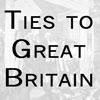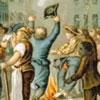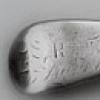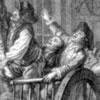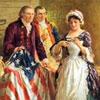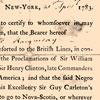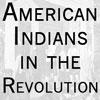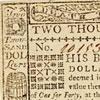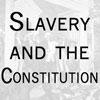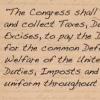The Revolution divided many Indian groups and alliances in Virginia and elsewhere. The Iroquois’ Six Nations confederation was one of the most powerful allied groups in the country at the start of the Revolution, but their loyalties split as groups such as the Seneca joined the British and the Mohawk allied with the Continentals. In 1779, the Seneca and other Iroquois allied with the British felt the direct effects of the war as General John Sullivan, following orders from George Washington, engaged in a scorched-earth campaign against them.
This excerpt from A Narrative of the Life of Mrs. Mary Jemison tells of the campaign’s effects on one Seneca group. Captured at the age of 15 along the Pennsylvania frontier and adopted into a Seneca community, Mary Jemison watched as Seneca lands became a battleground and their fields were laid waste.
The War for Independence Through Seneca Eyes: Mary Jemison Views the Revolution, 1775–79
Thus, at peace amongst themselves, and with the neighboring whites, … our Indians lived quietly and peaceably at home, till a little before the breaking out of the revolutionary war, when they were sent for, together with the Chiefs and members of the Six Nations generally, by the people of the States ….
Our Indians obeyed the call, and the council was holden, at which the pipe of peace was smoked, and a treaty made, in which the Six Nations solemnly agreed that if a war should eventually break out, they would not take up arms on either side ….
About a year passed off … when a messenger arrived from the British Commissioners …. [T]he British Commissioners informed the Chiefs that the object of calling a council of the Six Nations, was, to engage their assistance in subduing the rebels, … and added that they would amply reward them for all their services.
The Chiefs then arose, and informed the Commissioners of the nature and extent of the treaty which they had entered into with the people of the states, the year before, and that they should not violate it by taking up the hatchet against them.
The Commissioners continued their entreaties without success, till they addressed their avarice, by telling our people that the people of the states were few in number, and easily subdued … and that the Indians, if they would assist in the war, and persevere in their friendship to the King, till it was closed, should never want for money or goods.
Upon this the Chiefs concluded a treaty with the British Commissioners, in which they agreed to take up arms against the rebels ….
… Hired to commit depredations upon the whites, who had given them no offence, they waited impatiently to commence their labor, till sometime in the spring of 1776, when … a party of our Indians … shot a man that was looking after his horse, for the sole purpose, as I was informed by my Indian brother, who was present, of commencing hostilities.
In May following, our Indians were in their first battle with the Americans; but at what place I am unable to determine. While they were absent at that time, my daughter Nancy was born… .
… During the revolution, my house was the home of Col’s Butler and Brandt, whenever they chanced to come into our neighborhood …. Many and many a night I have pounded samp for them from sun-set till sun-rise, and furnished them with necessary provision and clean clothing for their journey.
For four or five years we sustained no loss in the war, except in the few who had been killed in distant battles; and our tribe, because of the remoteness of its situation from the enemy, felt secure from an attack. At length, in the fall of 1779, intelligence was received that a large and powerful army of the rebels, under the command of General Sullivan, was making rapid progress towards our settlement, burning and destroying the huts and corn-fields; killing the cattle, hogs and horses, and cutting down the fruit trees belonging to the Indians throughout the country.
… Sullivan arrived at Canandaigua Lake, and had finished his work of destruction there, and it was ascertained that he was about to march to our flats, when our Indians resolved to give him battle on the way and prevent, if possible, the distresses to which they knew we should be subjected, if he should succeed in reaching our town. Accordingly they sent all their women and children into the woods a little west of Little Beard’s Town, in order that we might make a good retreat if it should be necessary, and then, well armed, set out to face the conquering enemy….
At length a scouting party from Sullivan’s army arrived at the spot selected, when the Indians arose from their ambush with all the fierceness and terror that it was possible for them to exercise, and directly put the party upon a retreat. Two Oneida Indians were all the prisoners that were taken in that skirmish.
… Little Beard, who was standing by, as soon as the speech was ended, struck the prisoner on the head with his tomahawk, and despatched him at once!
Little Beard then informed the other Indian prisoner that as they were at war with the whites only, and not with the Indians, they would spare his life, and after a while give him his liberty in an honorable manner. The Oneida warrior, however, … watched for a favorable opportunity to make his escape; which he soon effected…. The Indians pursued him without success; but in their absence they fell in with a small detachment of Sullivan’s men, with whom they had a short but severe skirmish, in which they killed a number of the enemy, took Capt. or Lieut. William Boyd and one private, prisoners, and brought them to Little Beard’s Town, where they were soon after put to death in the most shocking and cruel manner.
… This tragedy being finished, our Indians again held a short council on the expediency of giving Sullivan battle, if he should continue to advance, and finally came to the conclusion that they were not strong enough to drive him, nor to prevent his taking possession of their fields: but that if it was possible they would escape with their own lives, preserve their families, and leave their possessions to be overrun by the invading army.
The women and children were then sent on still further towards Buffalo, to a large creek that was called by the Indians Catawba, accompanied by a part of the Indians, while the remainder secreted themselves in the woods back of Beard’s Town, to watch the movements of the army.
At that time I had three children who went with me on foot, one who rode on horse back, and one whom I carried on my back.
… In one or two days after the skirmish at Connissius lake, Sullivan and his army arrived at Genesee river, where they destroyed every article of the food kind that they could lay their hands on…. They burnt our houses, killed what few cattle and horses they could find, destroyed our fruit trees, and left nothing but the bare soil and timber. But the Indians had eloped and were not to be found.
… The weather by this time had become cold and stormy; and as we were destitute of houses and food too, I immediately resolved to take my children and look out for myself, without delay. With this intention I took two of my little ones on my back, bade the other three follow, and the same night arrived on the Gardow flats, where I have ever since resided.
At that time, two negroes, who had run away from their masters sometime before …. As they were in want of help to secure their crop, I hired to them to husk corn till the whole was harvested.
I have laughed a thousand times to myself when I have thought of the good old negro, who hired me, who fearing that I should get taken or injured by the Indians, stood by me constantly when I was husking, with a loaded gun in his hand, in order to keep off the enemy, and thereby lost as much labor of his own as he received from me, by paying good wages. I, however, was not displeased with his attention; for I knew that I should need all the corn that I could earn, even if I should husk the whole…. Many of our people barely escaped with their lives, and some actually died of hunger and freezing.
Some Indian groups believed the best course of action was to ally with the Continental army while others preferred to join the British. Still others believed it best to remain neutral. Indian groups and individuals made decisions in the interest of protecting their land and their future. They also considered previous ties to either the colonists or the English.
After the Revolution, the newly fledged American government used the fact that some American Indian groups allied with the British as justification for appropriating their lands.
Source: Mary Jemison, “The War for Independence Through Seneca Eyes: Mary Jemison Views the Revolution, 1775-79,” 1824, History Matters: The U.S. Survey Course on the Web, accessed September 20, 2011. Original in James E. Seaver, Narrative of the Life of Mrs. Mary Jemison (Canadaigua, NY: J.D. Bemis, 1824), 71-84.


